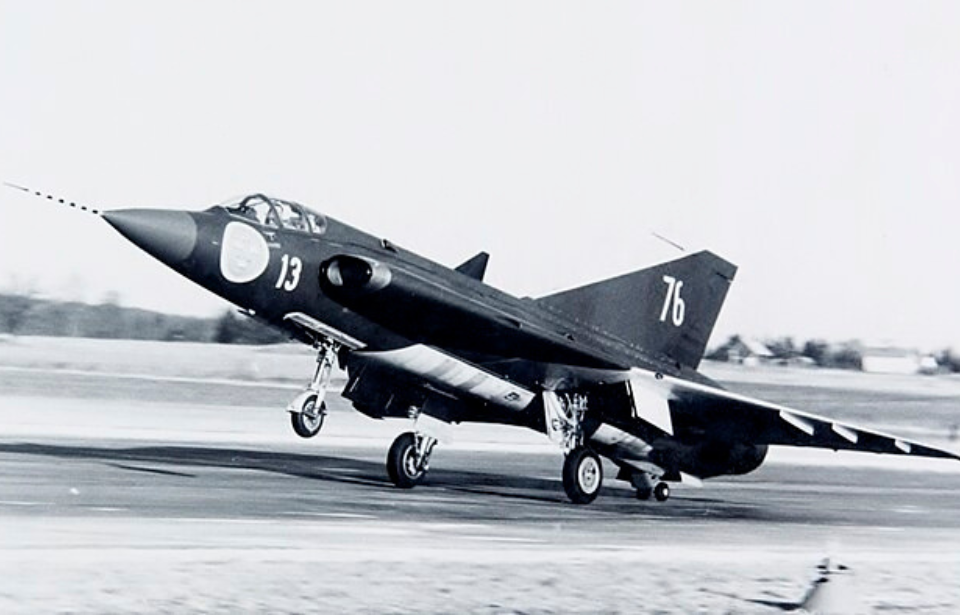After World War II, the need for faster and more advanced jet fighters grew rapidly. In the 1960s, Swedish engineers at Saab took on the challenge of designing the J35 Draken, starting with just a daring idea. They envisioned a fighter without a tail and featuring a double-delta wing—a shape that had never been tested before and carried serious risks.
Despite the obstacles, Saab’s team stayed determined, pushing ahead with creativity and persistence, like a dragon breathing fire. Thanks to their hard work and bold thinking, the Draken became a legendary aircraft and an important achievement in aviation history.
Development of the Saab J35 Draken
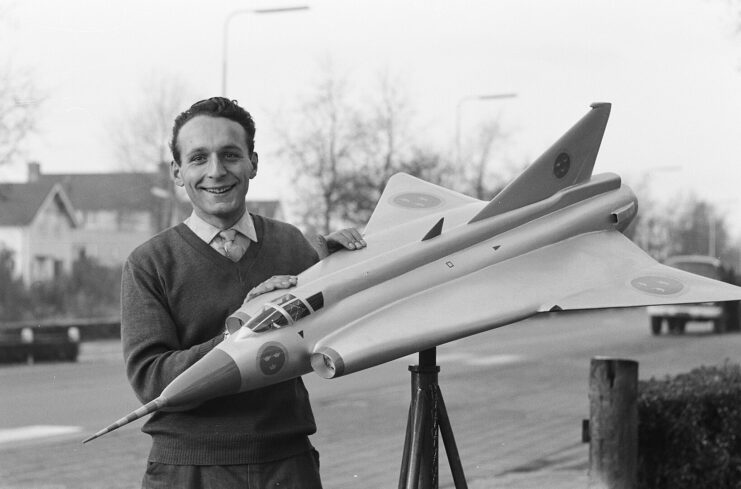
The Swedish Air Force, keen not to lag behind in the race for advanced jet fighter technology, began envisioning a supersonic fighter capable of intercepting bombers at high altitudes. A bold idea took root, and the Defence Materiel Administration announced a set of requirements for a state-of-the-art interceptor.
Unlike its contemporary, the US Air Force’s Lockheed F-104 Starfighter, this Nordic creation had a unique role to play; it was to operate from reinforced public roads, a strategy developed by the Swedish Ministry of Defence during the Cold War to protect against potential nuclear threats. It also had to be capable of conducting operations in all weather conditions.
Enter the Saab J35 Draken – the “Nordic Dragon” – which rose to the challenge.
The J35, a testament to innovative design and engineering prowess, was born from a daring decision to embrace the double-delta wing configuration. Despite being untested and potentially fraught with problems, it offered a solution to most critical issues. The delta wing, with its robust structure and large internal volume for fuel storage, seemed promising, albeit drag prone.
In the absence of modern aids like computer-aided testing and flight simulation, the Swedish engineers embarked on a slow and laborious undertaking. After extensive wind tunnel testing and test flights, they built a small but flyable prototype, the Saab 210 – or “Little Dragon.” Performing splendidly on its first flight over Stockholm in January 1952, the Little Dragon breathed life into the J35 Draken.
Saab J35 Draken specs
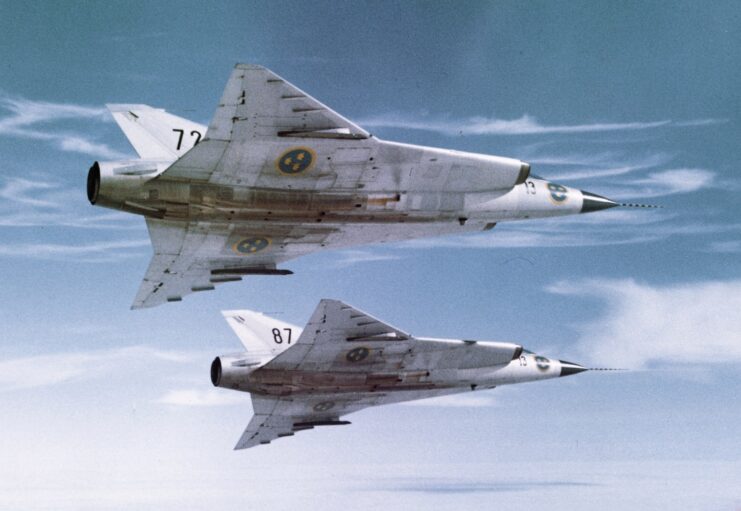
The J35 Draken stood out with its unique double-delta wing shape, which gave it excellent performance at both high and low speeds. The sharp angles helped it cut through the air efficiently while also providing stability during slower maneuvers.
Built for speed, the Draken was powered by a turbojet engine with afterburners, allowing it to fly at over twice the speed of sound—more than Mach 2. The cockpit gave pilots a wide, clear view, and the jet was equipped with advanced radar and fire-control systems that made it one of the most high-tech fighters of its era. Its body was split into front and rear sections, each carefully engineered to house key systems and components.
In terms of firepower, the J35 primarily carried up to four AIM-9 Sidewinder air-to-air missiles on its wings. It could also be armed with rockets and bombs stored inside the fuselage. For different mission needs, it could be outfitted with two 30 mm cannons or extra fuel tanks for extended range.
A rather bouncy start
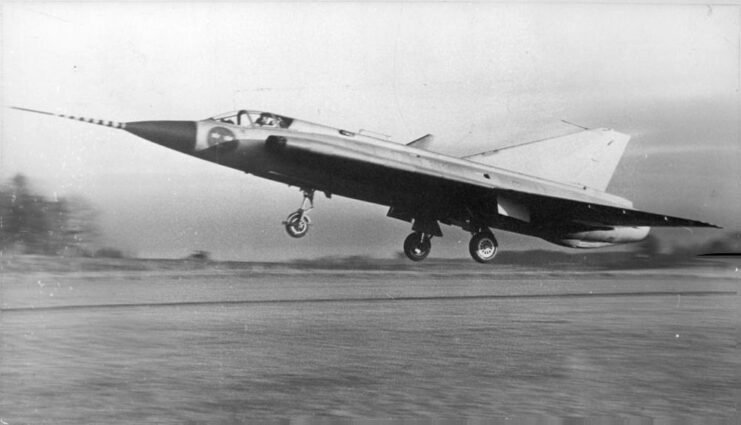
The Saab J35 Draken’s early days in service were anything but easy.
Its double-delta wing design was a groundbreaking concept, but it made the aircraft difficult to control. Landing required pilots to manually stabilize the jet, making every touchdown a high-risk challenge. However, there was an unexpected upside. While struggling to master the aircraft, pilots accidentally discovered a maneuver that no other country had figured out at the time.
Cobra Maneuver

While working to master the tricky J35 Draken, Swedish test pilots discovered an important flying technique called the Cobra Maneuver. When the Draken stalled at high angles of attack and became hard to control, they learned that by quickly lowering the angle of attack, they could break the stall and regain control of the jet.
This clever move essentially turned the Draken into a giant airbrake, allowing it to sharply reduce its speed in a matter of seconds. With its impressive speed, range, and advanced systems, the J35 reshaped the meaning of a “super stall.” The Cobra Maneuver became a daring display of controlled stalling, highlighting the aircraft’s remarkable agility and ability to slow down quickly when needed.
Saab J35 Draken’s legacy
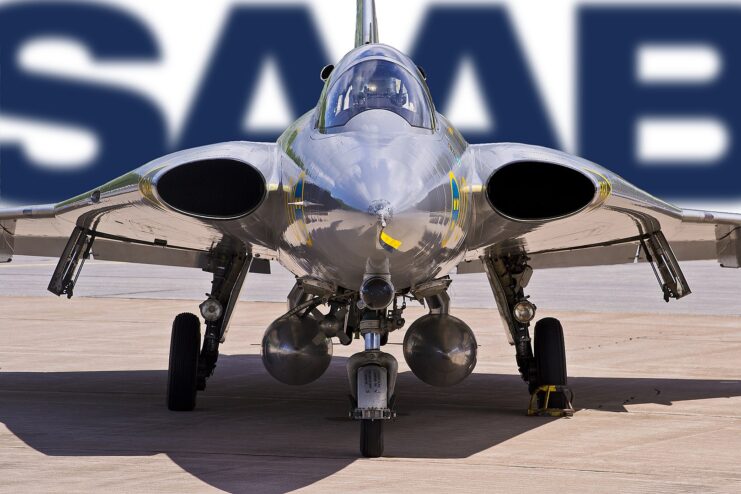
Not only was the J35 Draken a high-altitude interceptor, it also proved to be a capable dogfighter. With impressive quick-turn capability and its high speed, the Swedish fighter was twice as capable as other single-engine jets of the same era. The improved J35B model featured an enhanced power plant, an enlarged afterburner, a redesigned rear fuselage and integrated with the air defense control network, STRIL 60.
More from us: Why Did a Test Pilot Wear a Gorilla Mask In Flight?
While the Cobra Maneuver is now associated with more modern aircraft like the Sukhoi Su-27 and the Mikoyan MiG-29, it’s important to remember where it all began. The J35 Draken took the aviation world by storm and will be remembered as the aircraft that accidentally discovered the maneuver.
